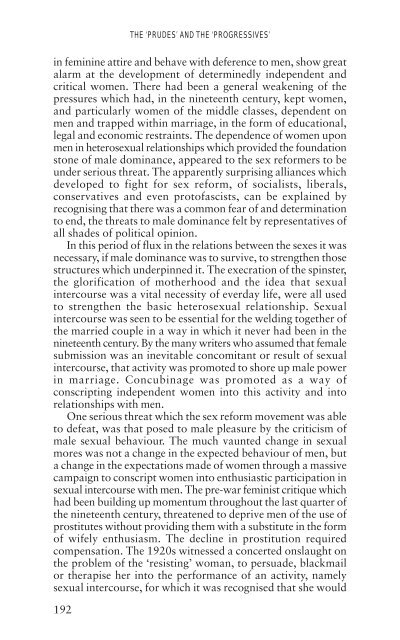The Spinster and Her Enemies - Feminish
The Spinster and Her Enemies - Feminish
The Spinster and Her Enemies - Feminish
Create successful ePaper yourself
Turn your PDF publications into a flip-book with our unique Google optimized e-Paper software.
THE ‘PRUDES’ AND THE ‘PROGRESSIVES’<br />
in feminine attire <strong>and</strong> behave with deference to men, show great<br />
alarm at the development of determinedly independent <strong>and</strong><br />
critical women. <strong>The</strong>re had been a general weakening of the<br />
pressures which had, in the nineteenth century, kept women,<br />
<strong>and</strong> particularly women of the middle classes, dependent on<br />
men <strong>and</strong> trapped within marriage, in the form of educational,<br />
legal <strong>and</strong> economic restraints. <strong>The</strong> dependence of women upon<br />
men in heterosexual relationships which provided the foundation<br />
stone of male dominance, appeared to the sex reformers to be<br />
under serious threat. <strong>The</strong> apparently surprising alliances which<br />
developed to fight for sex reform, of socialists, liberals,<br />
conservatives <strong>and</strong> even protofascists, can be explained by<br />
recognising that there was a common fear of <strong>and</strong> determination<br />
to end, the threats to male dominance felt by representatives of<br />
all shades of political opinion.<br />
In this period of flux in the relations between the sexes it was<br />
necessary, if male dominance was to survive, to strengthen those<br />
structures which underpinned it. <strong>The</strong> execration of the spinster,<br />
the glorification of motherhood <strong>and</strong> the idea that sexual<br />
intercourse was a vital necessity of everday life, were all used<br />
to strengthen the basic heterosexual relationship. Sexual<br />
intercourse was seen to be essential for the welding together of<br />
the married couple in a way in which it never had been in the<br />
nineteenth century. By the many writers who assumed that female<br />
submission was an inevitable concomitant or result of sexual<br />
intercourse, that activity was promoted to shore up male power<br />
in marriage. Concubinage was promoted as a way of<br />
conscripting independent women into this activity <strong>and</strong> into<br />
relationships with men.<br />
One serious threat which the sex reform movement was able<br />
to defeat, was that posed to male pleasure by the criticism of<br />
male sexual behaviour. <strong>The</strong> much vaunted change in sexual<br />
mores was not a change in the expected behaviour of men, but<br />
a change in the expectations made of women through a massive<br />
campaign to conscript women into enthusiastic participation in<br />
sexual intercourse with men. <strong>The</strong> pre-war feminist critique which<br />
had been building up momentum throughout the last quarter of<br />
the nineteenth century, threatened to deprive men of the use of<br />
prostitutes without providing them with a substitute in the form<br />
of wifely enthusiasm. <strong>The</strong> decline in prostitution required<br />
compensation. <strong>The</strong> 1920s witnessed a concerted onslaught on<br />
the problem of the ‘resisting’ woman, to persuade, blackmail<br />
or therapise her into the performance of an activity, namely<br />
sexual intercourse, for which it was recognised that she would<br />
192

















